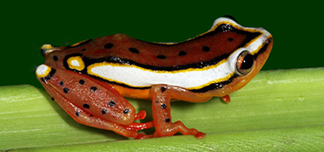You are here
Amphibians
Breviceps gibbosus (Linnaeus, 1758)
EOL Text
This species is endemic to the south-western Western Cape Province of South Africa, where it ranges from the central Cape Peninsula in the south, to west of Citrusdal in the north. There is a distribution gap in the Swartland. It ranges from sea level up to 1,000 m asl. Its Extent of Occurrence is 6,700 km2, with an Area of Occupancy estimated to be 10% of its Extent of Occurrence.
| License | http://creativecommons.org/licenses/by-nc-sa/3.0/ |
| Rights holder/Author | International Union for Conservation of Nature and Natural Resources |
| Source | http://www.iucnredlist.org/apps/redlist/details/3069 |
B. gibbosus is endemic to South Africa, Lesotho, and Swaziland (Text from Minter et al., 2004, © SI/MAB Biodiversity Program)
Females reach 80 mm in length and males are smaller (De Villiers 1988). The dorsal surface is rough in texture, and mottled in light and dark brown. A broad, central, creamy band with deeply serrated, dark edges is sometimes present, but more often is broken up to form two longitudinal rows of irregular, creamy patches. The ventrum is creamy white with brown mottling and has a rough texture (Text from Minter et al., 2004, © SI/MAB Biodiversity Program).
The only species with which B. gibbosus sometimes shares habitat is the much smaller B. montanus, which has a higher pitched, whistle-like call. The calls of B. fuscus and B. acutirostris are somewhat similar to those of B. gibbosus but these species are not sympatric with gibbosus (Text from Minter et al., 2004, © SI/MAB Biodiversity Program)
Habitat and Ecology
Systems
- Terrestrial
| License | http://creativecommons.org/licenses/by-nc-sa/3.0/ |
| Rights holder/Author | International Union for Conservation of Nature and Natural Resources |
| Source | http://www.iucnredlist.org/apps/redlist/details/3069 |
De Villiers (1988b) found that most localities where B. gibbosus occurs have fine grained, heavy substrates (loamy soils and clays) derived from shales or granites. B. gibbosus also occurs in disturbed and altered habitats, such as pine plantations and suburban gardens (Text from Minter et al., 2004, © SI/MAB Biodiversity Program).
Channing (2001) reports that B. gibbosus survives the long, dry summers by aestivation underground. Individuals produce a thin cocoon around themselves, with nostrils plugged and body inflated (Text from Minter et al., 2004, © SI/MAB Biodiversity Program).
B. gibbosus has a distinctive call, being more guttural (lower pitched and distinctly pulsed) than any other rain frog (Text from Minter et al., 2004, © SI/MAB Biodiversity Program).
Calling commences with the first winter rains (late April) and continues through to November. Calling occurs day and night in wet weather. Calling peaks at the beginning of winter and in spring, from late August to October, suggesting that warmer temperatures stimulate calling. Although calling usually occurs during and after rain showers, it sometimes precedes the rain by a few hours suggesting that this species may be able to detect the drop in barometric pressure that occurs in advance of a frontal weather system. Poynton and Pritchard (1976) noted a similar apparent connection between barometric pressure and surface activity in B. adspersus and B. verrucosus. Male B. gibbosus call from the surface, that is, they have never been observed calling from elevated perches as in some other Breviceps species. Calling males are usually well hidden under vegetation, in shallow depressions in the substrate (Text from Minter et al., 2004, © SI/MAB Biodiversity Program).
As in other Breviceps species, adhesive amplexus is employed when mating (Wager, 1965). In dense choruses, males will attempt to clasp any moving object in the vicinity, including other males (Text from Minter et al., 2004, © SI/MAB Biodiversity Program).
Red List Criteria
Year Assessed
Assessor/s
Reviewer/s
Contributor/s
Justification
History
-
2004Vulnerable (VU)
-
1996Vulnerable (VU)
-
1994Vulnerable (V)
| License | http://creativecommons.org/licenses/by-nc-sa/3.0/ |
| Rights holder/Author | International Union for Conservation of Nature and Natural Resources |
| Source | http://www.iucnredlist.org/apps/redlist/details/3069 |
